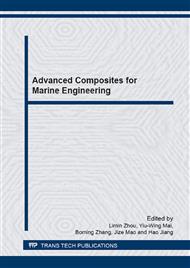p.102
p.109
p.116
p.127
p.133
p.140
p.147
p.152
p.161
Effect of Aging on the Performance of Glass Fiber Reinforced pCBT Resin
Abstract:
In the present paper, pCBT casts and pCBT/E-glass fiber composites were prepared. In order to study the mechanical performance of the thermoplastic material in the aging environment, the specimens were exposed to salt spray, hygrothermal as well as immersion conditions. The hygroscopicity and mechanisation of the material were studied. From this research work, it is found that, in corrosion tests, the water absorb rate increases at the beginning of the test and decreases with the increase of time. Chloride ion concentrationb and a higher corrosion time have some influence on the moisture absorption kinetics. The results also show that the mechanical properties such as modulus and strength of pCBT and its glass fiber composites change with the trendency of moisture absorption curves.
Info:
Periodical:
Pages:
133-139
Citation:
Online since:
March 2015
Authors:
Price:
Сopyright:
© 2015 Trans Tech Publications Ltd. All Rights Reserved
Share:
Citation:


